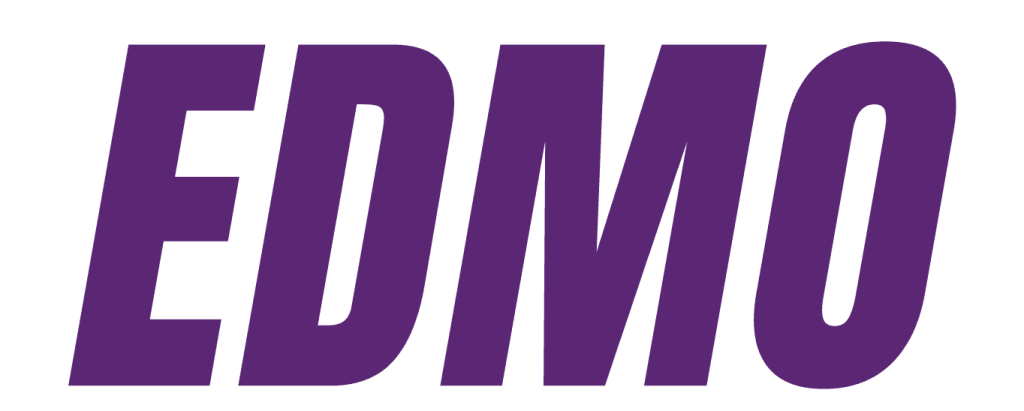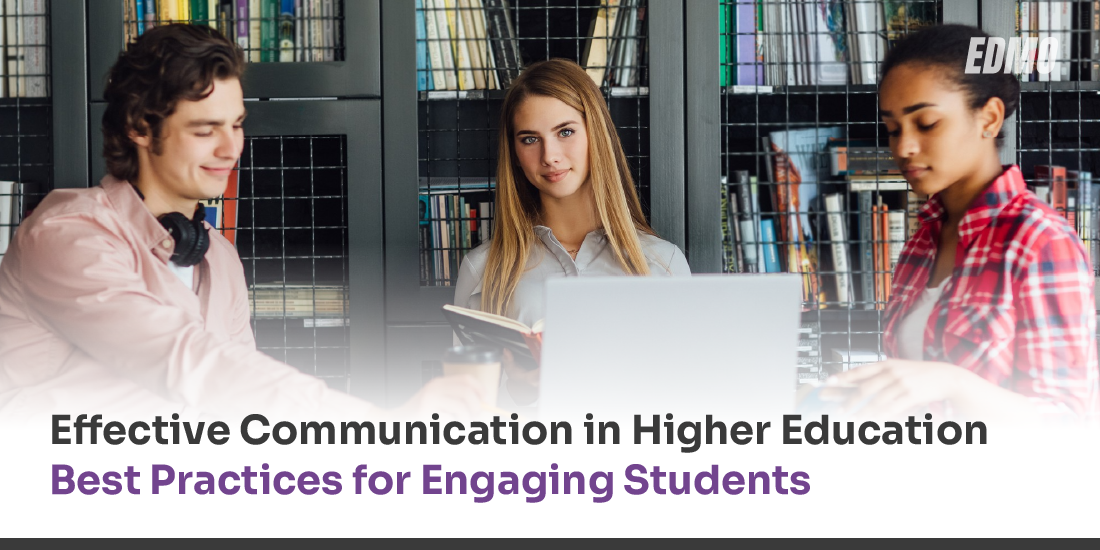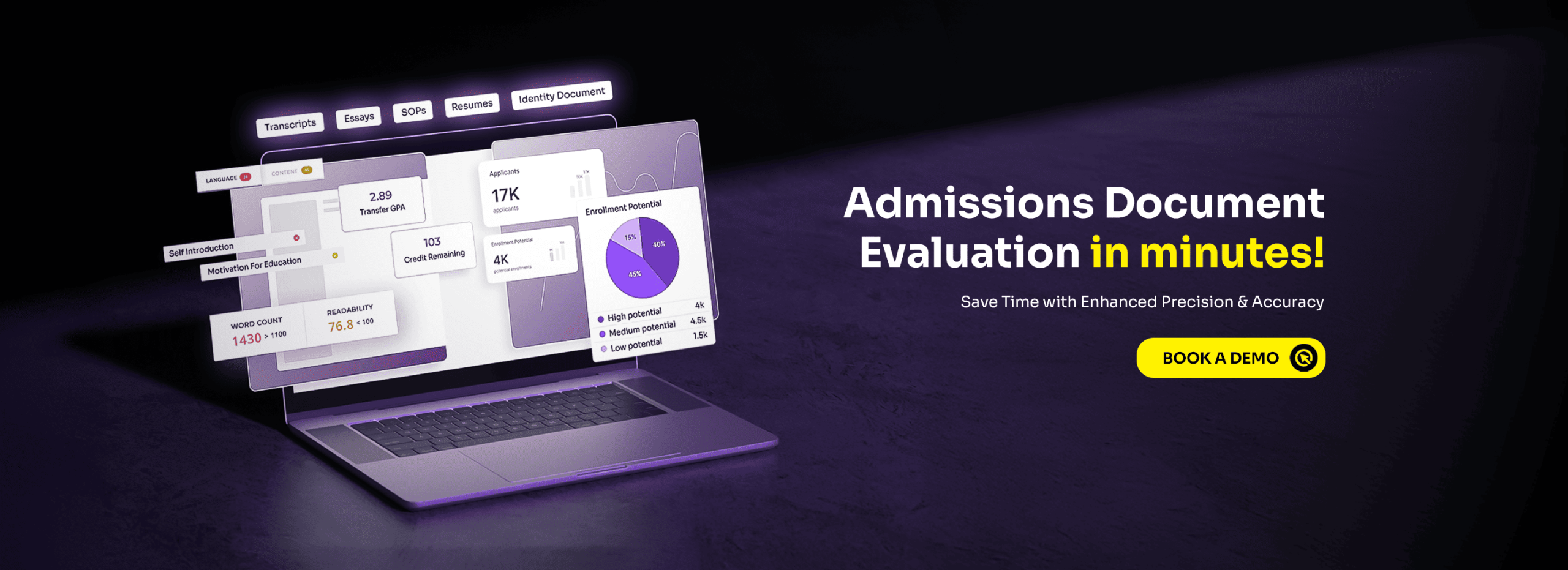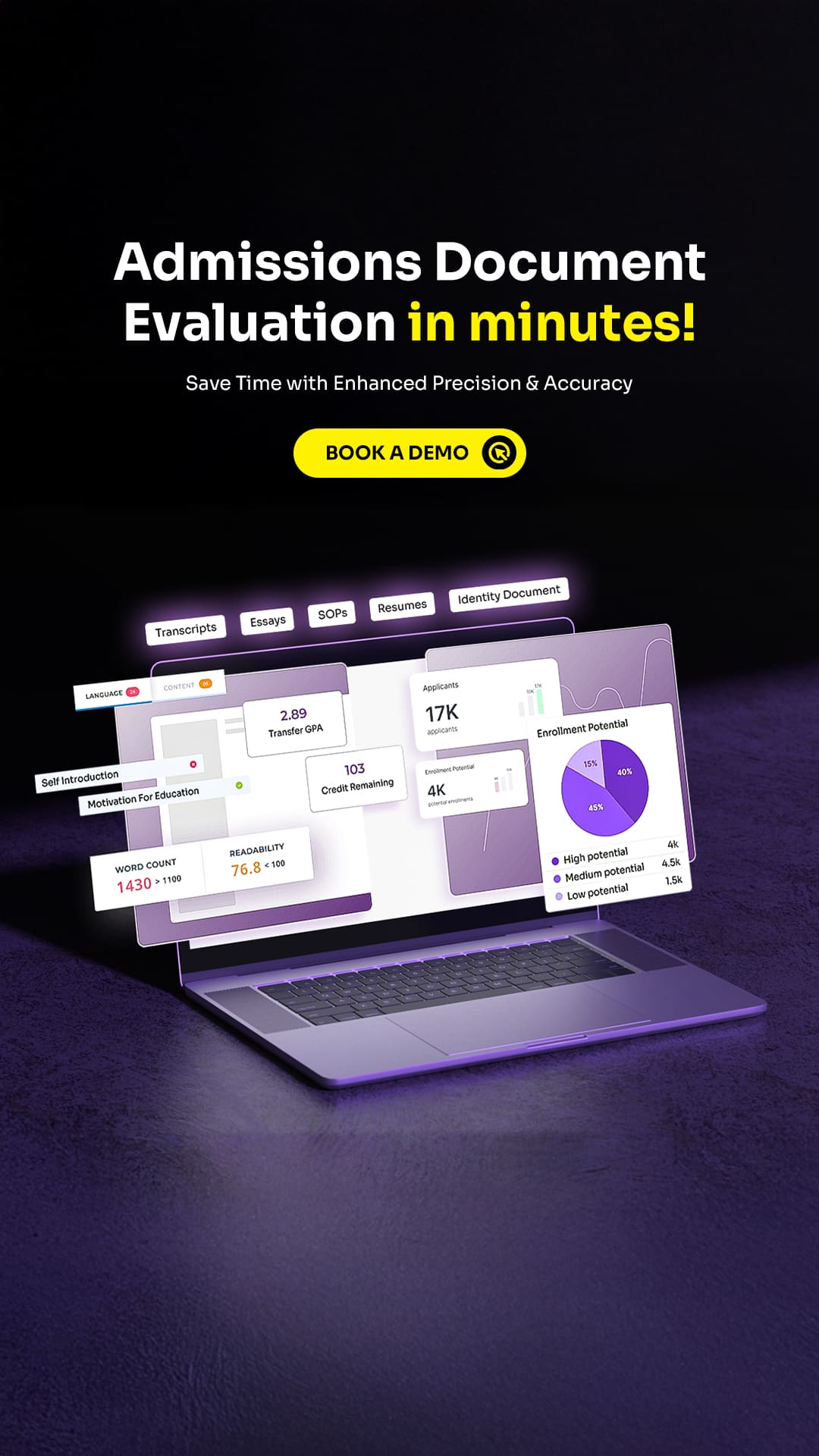Table Of Contents
Introduction
Effective communication in higher education isn’t just “sending info”—it’s designing interactions that drive action, clarity, and belonging. Evidence is clear: active-learning approaches (such as polls, think-pair-share, and short reflections) lift exam performance by roughly half a letter grade and reduce failure rates compared to lectures, making messages more effective because students engage with them. Timely, specific feedback further boosts engagement and outcomes yet remains a common pain point in courses. Channels matter too: students primarily work on laptops but rely on smartphones as their secondary tool, so concise, mobile-friendly nudges win attention. Real-world results back this up. Georgia State’s AI texting chatbot cut “summer melt” from 19% to 9% by delivering rapid, actionable messages to admitted students with precisely the correct info at the right time. Arizona State’s adaptive-courseware initiative, coupled with faculty support, demonstrates that structured, feedback-rich learning design can scale communication without losing the human touch.
The Challenges Facing Higher Education Communications

Higher education communicators navigate fast-changing modern audiences, channels, and expectations while protecting institutional reputation and driving enrollment. Fragmented data, limited budgets, and scrutiny from students, faculty, alumni, and media intensify the pressure. These ten challenges—and practical responses—summarize what most teams face today and how to build resilient, student-centred communication systems.
Fragmented Audiences & Channel Overload
Students, parents, alumni, faculty, media, and policymakers all expect different tones and formats across email, SMS, social, portals, and apps.
Impact: Duplicated effort, inconsistent messages, missed engagement.
What to do: Map audience personas; define channel purpose; set a send cadence calendar; consolidate lists; use preference centres to let users choose topics and frequency.
Personalization at Scale
Prospects expect Netflix-level relevance; generic blasts underperform.
Impact: Lower open/click rates, weak conversions, poor student experience.
What to do: Centralize data (CRM + SIS); segment by intent, stage, and behaviour; use dynamic content blocks; trigger journeys from real actions (opens, form fills, event check-ins).
Speed vs. Accuracy in Crises
Safety alerts, policy changes, and campus incidents demand minutes, not hours—without sacrificing accuracy.
Impact: Confusion, reputational damage, legal risk.
What to do: Pre-approve message templates, define an incident communications tree, maintain a single source of truth page, rehearse tabletop drills, and enable SMS/push notifications for urgent tiers.
Data Silos & Weak Analytics
Marketing tools, CRM, SIS, and ticketing systems rarely “talk,” limiting insights.
Impact: Incomplete funnel visibility; hard to attribute ROI.
What to do: Implement ETL/Reverse-ETL to a warehouse or CDP; standardize IDs; create a shared KPI dashboard (reach, engagement, conversion, yield); review monthly with stakeholders.
Brand Consistency Across Decentralized Units
Schools, departments, and centres improvise assets, diluting the brand.
Impact: Confusing identity; inefficient creative cycles.
What to do: Publish a living brand system (voice, tone, accessibility rules); provide approved templates/components; set a light-touch review process; run quarterly audits with feedback.
Accessibility, Inclusivity & Compliance
ADA/WCAG, FERPA/GDPR, and inclusive language standards are non-negotiable.
Impact: Exclusion, complaints, compliance risk.
What to do: Enforce alt-text and contrast checks; caption all videos; create inclusive style guidance; add pre-send accessibility linting; train student workers and faculty editors.
Misinformation & Rumour Control
Unofficial posts can outrun official channels.
Impact: Erosion of trust; media escalations.
What to do: Monitor social/listservs; publish fast FAQs with time-stamped updates; empower spokespeople; correct publicly and link to the canonical update hub.
Budget Constraints & Proving ROI
Leaders fund what they can measure.
Impact: Under-resourced teams, stalled tools, missed innovation.
What to do: Tie comms to pipeline and retention metrics; baseline current performance; run A/B tests; report cost-per-inquiry/visit/enrollment; reallocate from low-yield channels to proven ones.
Internal Alignment & Change Management
Competing priorities across admissions, marketing, IT, student affairs, and faculty create noise.
Impact: Mixed messages, duplicated outreach, and initiative fatigue.
What to do: Establish an editorial board; share a quarterly content roadmap; adopt intake forms and SLAs; hold short standups during peak cycles; celebrate shared wins.
Tech Stack Sprawl & Adoption Gaps
CRMs, marketing automation, chat, events, and CMS tools multiply—users don’t fully adopt them.
Impact: Shelfware, manual workarounds, data drift.
What to do: Rationalize tools; document “golden paths” (standard workflows); build template libraries; appoint product champions; track feature adoption and retire duplicative apps.
Importance of Effective Communication in Higher Education
Effective communication underpins student success, institutional trust, and operational efficiency. In universities, it aligns diverse stakeholders, clarifies policies, accelerates crisis response, and personalizes engagement at scale. When done well, it raises enrollment and retention, reduces the support load, improves inclusivity and compliance, and turns data into actionable insights across all channels and touchpoints.
Boosts Student Success & Retention
Clear, timely instructions help students meet deadlines, access aid, and navigate registration/advising. Consistent reminders reduce confusion, course drops, and stop-outs—especially at term milestones (orientation, add/drop, census, midterms).
Improves Enrollment & Yield
Right message, right time outreach converts inquiries into applications and deposits. Segmenting by stage, intent, and behaviour enables personalized content (program fit, scholarships, visit invites) that lifts applications started/completed and admit-to-enrol rates.
Builds Trust & Protects Reputation
Transparent updates—time-stamped and easy to find—limit rumours and media escalations. A single “source-of-truth” page and consistent spokespersons convey credibility, reducing misinformation and stakeholder anxiety.
Enables Rapid, Accurate Crisis Response
Pre-approved templates, clear roles, and multi-channel alerts (SMS, email, push, banners) shrink detection-to-notification time. Practised playbooks prevent errors under pressure and keep the community safe and informed.
Aligns Faculty, Advisors, and Staff
Shared editorial calendars, intake forms, and SLAs prevent duplicate or conflicting messages. When internal teams communicate clearly, students experience a coherent journey instead of mixed signals.
Strengthens Accessibility & Inclusion
Plain language, captions, alt text, adequate contrast, and key translations widen access and meet WCAG/ADA expectations. Inclusive communication ensures all students can understand and act on information.
Clarifies Policies & Reduces Support Load
Readable policy hubs, featuring FAQs, examples, and straightforward decision flows, transform complex rules into practical guidance. Self-service answers lower ticket volume and compliance risk.
Elevates Digital Experience & Self-Service
Well-structured sites/portals, strong search capabilities, knowledge bases, and chatbots enable users to complete tasks quickly (such as paying, registering, or checking aid). Faster task completion improves satisfaction and reduces call-centre strain.
Deepens Alumni Engagement & Giving
Storytelling tailored to affinity (program, geography, class year) and timely stewardship (thank-you, impact updates, invitations) sustains relationships and increases event participation, volunteerism, and donations.
Drives Continuous Improvement & ROI
Dashboards tied to outcomes (yield, persistence, ticket deflection) and routine A/B testing spotlight what works. Leaders can retire low-performing channels and invest in proven tactics, demonstrating measurable value.
How to Make your Communication more Effective?

Effective communication turns intent into action across the student lifecycle. When messages are personalised, accessible, and timely—delivered on the channels students prefer—applications are completed, aid is verified, crises are de-escalated, and persistence improves. The tactics below pair practical steps with credible data and real campus examples you can replicate today.
Start with channels students actually prefer
Prioritize email for planned updates and summaries; reserve SMS/push for time-sensitive nudges. Salesforce’s Connected Student research shows that email remains students’ most preferred channel, making it a reliable backbone for weekly digests and milestone guidance.
Segment and personalize to lift engagement
Move beyond blasts. Segment by stage, intent/major, and behaviour (opens, event attendance, form starts). Education emails routinely outperform other industries—according to benchmarks, they report open rates of 25–28% and strong click-throughs when the content is relevant—so use dynamic blocks (program fit, scholarships, deadlines) to drive conversions.
Use behavioural nudges to drive task completion
Simple, timely reminders close intention–action gaps. Randomized trials of “summer nudging” via personalised texts increased college enrollment, particularly for students with less support; effects range from 3 to 6 percentage points depending on context and design. Make nudges actionable (one task, one link).
Deploy chatbots for 24/7, high-volume Q&A
AI assistants handle repetitive, deadline-driven questions, allowing humans to focus on complex advising. Georgia State’s “Pounce” chatbot answered 200k+ questions in its first summer and cut summer melt by 22% (324 students), showing how always-on support converts intent into enrollment.
Orchestrate multi-channel crisis comms—fast and consistent
Create pre-approved templates (SMS/email/web banner) and a single “update hub” page. The Clery Act requires timely warnings and distinct emergency notifications; rehearsed playbooks and clear roles reduce detection-to-alert time and limit rumour cycles.
Build accessibility in from the start
Caption video, add alt text, ensure colour contrast, and use plain language. High-profile settlements with Harvard and MIT over online captioning underscore the legal and ethical stakes; accessible content broadens reach and reduces complaints.
Publish a plain-English policy hub with decision flows
Turn complex rules (add/drop, FERPA, financial aid verification) into short FAQs and if-this-then-that flows. EDUCAUSE trend work highlights the growing expectation for clear, self-service digital experiences—reduce tickets by answering questions where students already are.
Run a weekly “What to do this week” digest + targeted SMS for critical deadlines
Pair a concise, scannable email (≤150 words, one CTA) with deadline-only texts (e.g., FAFSA verification, registration holds). Research on FAFSA/text interventions indicates that well-timed prompts can enhance completion and persistence when messages are tailored and personalised.
Instrument everything—dashboards tied to outcomes, not vanity metrics
Report how comms affect application completion, yield, ticket deflection, and persistence. Benchmarks show that education emails can achieve strong CTORs when the content is value-rich; use A/B tests to retire low performers and scale what drives outcomes.
Pair communication with wraparound support for outsized impact
When messaging is coupled with structured supports (advising cadence, resource reminders, transit/aid info), results compound, CUNY’s ASAP model nearly doubled three-year graduation rates (40% vs. 22%) in rigorous studies—clear, frequent touchpoints were part of the formula.
Tips for Successful Communication
Successful communication turns attention into action. It starts with clear goals, the right audience, and plain, accessible language—then travels on the best-fit channels at the right time. Layer in personalization, two-way feedback, and tight measurement, and you’ll consistently drive higher engagement, faster decisions, and better student and stakeholder outcomes.
Define audience & goal first
Know who you’re speaking to and what one action you want next (apply, RSVP, pay, read). Write the call-to-action (CTA) before the message, then build everything around it.
Keep it clear, short, and skimmable
Use plain language, front-load the “so what,” and limit to one primary CTA. Break long content into headings, bullets, and links to details. Aim for ≤150 words in routine notices.
Segment & personalize
Tailor by lifecycle stage, program/interest, behaviour (opens, visits, forms), and geography. Use dynamic content blocks (such as deadlines, scholarships, and events) so that each person sees what’s relevant to them.
Choose the right channel mix
Email for summaries and instructions; SMS/push for urgent, time-sensitive tasks; web/portal as the primary source; social media for awareness and community engagement. Always link back to a single, up-to-date page.
Time it right & set a steady cadence
Send when your audience is most responsive (test to find your window). Create predictable rhythms: weekly student digest, post-event follow-ups within 24 hours, deadline reminders 7/3/1 days out.
Build in accessibility & inclusion
Use alt text, captions, adequate colour contrast, and mobile-first layouts. Avoid using jargon; translate key terms where necessary. Accessibility isn’t a review step—it’s part of the drafting and QA process.
Invite a two-way conversation
Add quick-reply options (Yes/No, 1-click RSVP), short forms, or chat for clarifications. Close the loop with confirmations (“You’re registered”) and next steps to reduce follow-up questions.
Measure, learn, and iterate
Track opens/clicks → task completion (the real KPI). A/B test subject lines, CTAs, and send times. Retire low-performers and scale what works. Share a simple dashboard so everyone sees the impact.
Summary
Effective communication on campus is less about pushing notices and more about shaping decisions, confidence, and community. When messages are transparent, timely, and easy to act on—especially on mobile—students register on time, complete their applications, and resolve aid issues more quickly. Learning improves, too: interactive teaching and quick feedback consistently raise performance and lower the risk of failure because students stay engaged and know how to improve their work. Channel strategy matters: use email to summarize and guide, SMS/push for urgent nudges, and a single, updated webpage as the source of truth. Real implementations demonstrate the payoff—AI text assistants that answer thousands of questions can significantly reduce “summer melt,” and adaptive course designs help instructors scale feedback without sacrificing the human touch. Behind the scenes, the strongest programs align teams on consistent branding, accessibility from draft to delivery, and data that track outcomes (task completion, yield, retention). Measure, iterate, and fund what demonstrably works.









No comments yet. Be the first to comment!
Leave a Comment